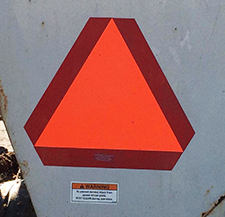 The roadways can be a dangerous place, no matter what your mode of transportation. But, for farmers, there are times when public roads are the only way to get field equipment from Point A to Point B. When moving implements of husbandry on public roads, safety must be front and center.
The roadways can be a dangerous place, no matter what your mode of transportation. But, for farmers, there are times when public roads are the only way to get field equipment from Point A to Point B. When moving implements of husbandry on public roads, safety must be front and center.This important topic was the focus of a breakout session at the North American Manure Expo, held last week in Chambersburg, Pa. Police officers Greg Fisher and Mitchell Saflia addressed the crowd with some statistics, food for thought and recommendations for safer roadway travel.
To start off, Fisher said, "Have a safe attitude." Saflia agreed and said, "It starts with you. Get in the right mindset."
Last year in Pennsylvania alone, there were 101 farm vehicle related crashes, up from 87 in 2013. Those incidents included seven fatalities. "One fatality is too many," said Saflia. "That's why we're here."
The officers reminded farmers that their slow moving implements are competing for road space with smaller, faster moving cars. Often, machinery is taller, wider and more cumbersome than smaller, more nimble cars. Farm equipment is also typically older and might not be equipped with all the safety features found in passenger vehicles. Add these characteristics to the fact that country roads often have more hills, more curves and limited or no shoulder space, and sharing the roadways can be quite hazardous.
Fisher and Saflia pointed out the most common situations that can cause accidents, including left turn collisions, rural bridges, unsafe passing and rear end collisions.
Their number one piece of advice was to have a slow moving vehicle emblem on all implements. For enhanced visibility, they also recommended marking edges of tractors and machinery with reflective tape and or adding other reflectors. Older equipment should be retrofitted with improved lighting, and lights should always be turned on.
The officers recommended that farmers do routine vehicle maintenance on all tractors and machinery. They also encouraged drivers to do a pretrip walk around to be sure everything is in working order.
To steer clear of more dangerous situations, avoid traveling the roads with implements of husbandry during rush hour or in bad weather, and avoid nighttime driving if possible. The officers also offered a strong reminder to not allow additional riders.
"Be safety aware," Fisher concluded, "and remember to always wear your seatbelt."

The author is an associate editor and covers animal health, dairy housing and equipment, and nutrient management. She grew up on a dairy farm near Plymouth, Wis., and previously served as a University of Wisconsin agricultural extension agent. She received a master's degree from North Carolina State University and a bachelor's from University of Wisconsin-Madison.








